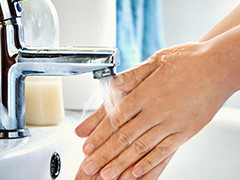Wash Your Hands the Right Way

It’s easy to take hand washing for granted. It seems mundane, because it’s something we do multiple times every single day, but it actually is one of the most effective ways to avoid sickness.
Use your best judgment when it comes to how often you should be washing your hands. It’s better to be cautious and wash them whenever you’re in doubt. The Centers for Disease Control and Prevention (CDC) suggests several key moments when you should always wash your hands, because you’re exposed to germs and/or could spread them to others.
Handwashing only works when it’s done correctly, though. The CDC recommends you follow these steps every time you wash your hands:
- Turn on clean, running water. The water temperature isn’t too important.
- Wet your hands then generously lather them up with soap. Studies show that antibacterial soap isn’t more effective than regular soap.
- Scrub for at least 20 seconds. Germs are everywhere on your hands—be sure to scrub between your fingers, on top of your hands, under your nails and on your wrists.
- Rinse off your hands thoroughly under the water. Soap lifts germs off your hands, and running water sends them down the drain.
- Dry your hands off. Use a paper towel or hand towel. If you’re using a hand towel, make sure it’s washed often.
Disinfecting your hands with hand sanitizer isn’t a replacement for washing your hands. That being said, it’s a good backup for the times when you can’t wash your hands. Just be sure that it contains at least 60% alcohol, and that you use plenty of it.
If you do find yourself feeling under the weather, prevent germs from spreading by staying home. Always consult with a doctor about the best course of action when you’re sick. Don’t forget that you can get care from a board-certified doctor without leaving your home by using telehealth services.


